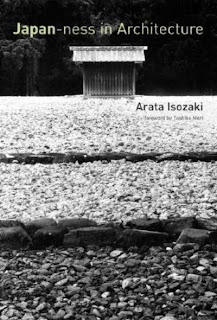
Arata Isozaki is a Japanese architect, who sees buildings not as dead objects but as events that encompass the social and historical context. His works include Barcelona's Olympic Stadium, the Los Angeles Museum of Contemporary Art, the Tokyo University of Art and Design, and the Team Disney Building in Orlando, FL. Isozaki is also an intelligent and thoughtful critic and philosopher of architecture, and has penned numerous essays on Japanese design principles.
He spent twenty years to complete these essays in Japan-ness in Architecture, starting in the early 1980s. These essays demand the readers to view things as more complicated or even confused. His references are not all pleasing, and many are controversial. He destroys the readers’ stereotypical idea of “Japan-ness” in architecture. He uses events, personalities, and cultural influences on each building to engage the readers with the true meaning and the quality of the building. He also claims that what others consider to be the Japanese aesthetic is often the opposite of that essential Japan-ness born in moments of historic self-definition, the purified stylization, which he calls "Japanesquization". It lacks the energy of cultural transformation and reflects an island retrenchment in response to the pressure of other cultures.
Isozaki's writings offer a special challenge to the Western concept of architecture: "Architectural discourse demands that we view buildings as events and not simply as inert objects. In a sense this might be equivalent to grasping the buildings as textual spaces. By not only considering the objectness of buildings but also discussing the texts written about them, thus shifting the stance to the metalevel, I believe we can reconstruct the problematic that each building originally internalized." He presents the question of what did architecture in Japan lose after it entered modernism? He explains it by identifying what is essentially Japanese in architecture from the seventh to the twentieth century, by organizing the book into four main sections; Japan-ness in Architecture, A Mimicry of Origin: Emperor Tenmu’s Ise Jingu, Construction of the Pure Land (Jodo) Chogen’s Rebuilding of Todai-ji, and A Diaonal Strategy Katsura as Envisioned by “Enshu Taste”. These buildings are the selected true “Japanese” architecture by Isozaki.
In the first essay, Isozaki analyzes the struggles of modern Japanese architects, including himself, to create something uniquely Japanese out of modernity. It also includes thoughtful accounts of Frank Lloyd Wright's design of the Imperial Hotel in Tokyo, and Bruno Taut’s designs in Japan. In the second essay, “Western Structure versus Japanese Space”, he describes how Japanese design is as much about emptiness as it is about structure. It is a perspective that comes naturally to the country that gave Zen Buddhism to the world. He then circles back in history to find what he calls Japan-ness in the seventh-century Ise shrine, reconstruction of the twelfth-century Todai-ji Temple, and the seventeenth-century Katsura Imperial Villa.
Ise’s architecture in the context of the unique system of renewing the precincts, which is called shikinen-zokan, it may seem improper to define it by way of the Western concept of an everlasting materiality. It may not be considered as architecture. However, these ideas are just evolved from the Western idea of architecture. This ritual of rebuilding and relocating reiterated, represent the Zen idea of Japanese architecture. Isozaki claims that the unknown, not logical concept behind Ise Shrine is a quality of Japan-ness, compare to the Western logical approach to architecture.
Isozaki explains that Katsura as "a text rich in ambiguity, where architectural languages of quite different formal and temporal inspiration are juxtaposed. These layers of approach and language have made Katsura an object of incessant new reading strategies". Its main trait is that it has no clearly defined, dominant form or style, and number of design methods is used in both building and garden. Katsura is considered as a layered space, which includes transparent interior, shoji screens, and the use of shelves. Isozaki also questions the authorship of Katsura. Baruno Taut named Enshu as the designer and until the 1930s that was the most commonly held view. Isozaki states that Taut’s statement is built around a blind spot, one concerned with the concept of authorship itself. In Samurai society and the shogunate, Enshu’s status is ambiguous and cannot be defined by Western style of “hierarchy” or “authorship”.
This book is a great text to understand the hidden complex quality of Japanese architecture. Isozaki forces our minds to be free and flexible culturally. His philosophy is reflected on his analysis of the buildings. For non-Japanese speaking people, the cultural background and the Japanese terms may be hard to follow and understand. As Isozaki explains, Japanese culture is ambiguous and intricate. However, the ten-page glossary in the end should be helpful to look at, just to ne familiar with the building, names and technical terms.
Another great quality about this book is that each essay focuses on a very specific topic, on each building and social issue is that is related, to understand the bigger topic, such as Ise, Katsura, and Todaiji. Especially if the reader has not been to these buildings, the great description and the narrative of the building would be a great help to visualize them.
In order to understand the quality of traditional Japanese architecture that is missing in contemporary architecture is listed in this book. As I keep reading through the book, I am confident that the complex answer should rise.
No comments:
Post a Comment